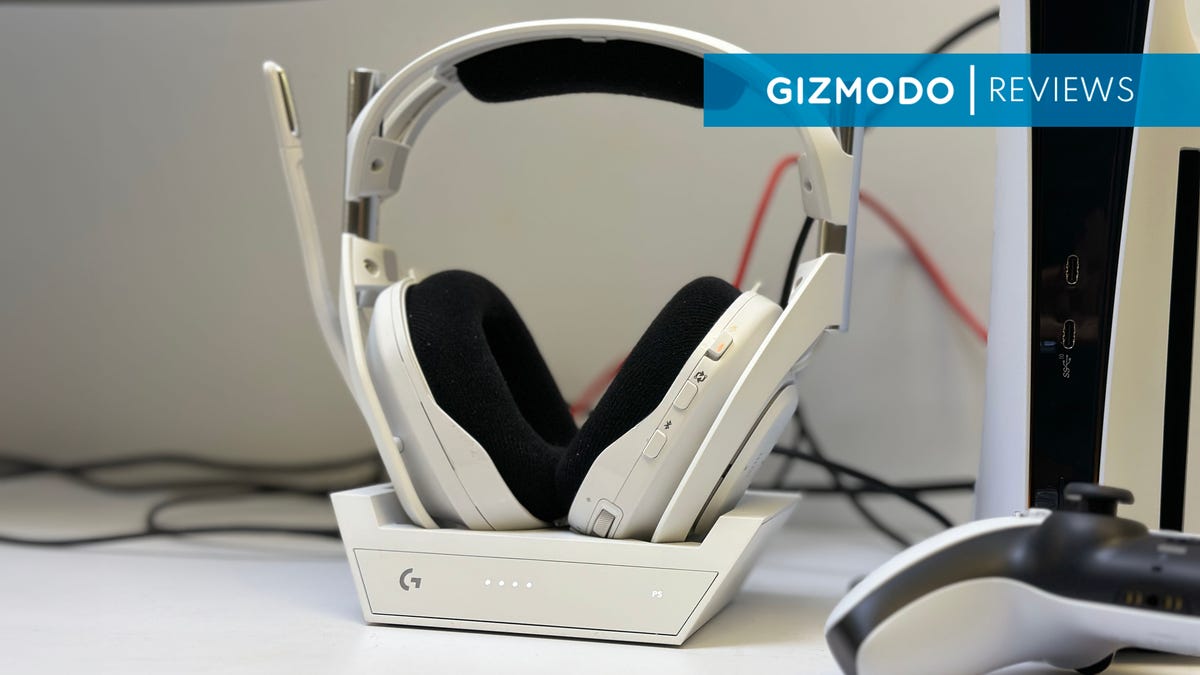The initial pitch for the $380 Logitech Astro A50 X Lightspeed headset sounds like an infomercial. It’s as if a revived, gamer-ified Billy Mays made a 30-second TV pitch sounding off: “Are you tired of shoving all those dongles in your consoles? Do you hate that it’s so hard to use the same headset across all your gaming devices? Then strap these headphones on and quit the hassle. Play on your PlayStation 5. Play on your Xbox Series X/S, then switch to your PC. It’s all there, no fuss, no muss.”
Thanks, Billy, but does it actually work?
Yes, but at its price, it only makes sense if you’re the fortunate soul with every single one of their consoles and gaming PCs within a few feet of each other.
Just like all those old infomercials, there are a fair bit of caveats not made clear in the Astro A50X’s initial pitch. The headset is a fancy, comfortable, premium pair of headphones and a base station that works as advertised. However, the necessary cabling to connect all your consoles to the TV means this device is built for a gaming gopher with their own exclusive den meant to play all their separate consoles in a small, contained space.
It connects all your devices to the same microphone, though only if you don’t have any friends, family, or roommates who also like to use the connected PC while playing your PS5 from the couch.
Logitech’s all-in-one headset also requires you to plug in even more wires to what’s likely a cramped power strip behind your television cabinet. If you’re big into cable management, that shouldn’t be too big a problem. If you’re like me, then the back of your case will look like a snake pit big enough to give Indiana Jones pause. If you want audio and mic access, every console must use a separate HDMI and USB-C connection to the Astro A50 X’s base station, which then passes through the connection to the television.
Otherwise, the wireless A50 X contains a good-quality set of cans—everything you might expect from an expensive, premium gaming headset. If you’ve ever used an Astro A50 headset, this is the same device but with the extra setup. That older headset cost $300 MSRP when it first hit store shelves. Is the additional $80 worth having a single headset for all your game-playing needs? For some, maybe, but for me? No, probably not.
Logitech Astro A50 X Setup
Be Prepared to Have Some Extra HDMIs on Hand for Your A50X
To get the most out of the A50 X, you’ll likely need to have an Xbox Series S or X console as well as a PlayStation 5 sitting around the same television cabinet, but right off the bat, it’s important to note it’s not as simple as plugging it in and sitting down with a controller in hand. The Astro base station requires that you connect all the HDMI 2.1 cables from the consoles directly to the base station. The system is a passthrough from your consoles to your TV for all intents and purposes. The headset has one power cable attached to a split USB to plug into your PC. It also comes with one HDMI 2.1 cable and another USB to USB-C cord, but to plug in both consoles, you’ll need to procure another set of each. Each console must connect to the base station through USB and HDMI to access audio and voice, all of which go to your monitor or TV.
It’s not an especially difficult process so long as you follow Logitech’s video instruction guides, but even then, you’re not done. Logitech also needs you to jump onto both your Xbox and PlayStation to change the sound and voice settings to get the most out of your headset. For instance, on the PS5, you need to make sure the audio is going through your TV rather than the headset. If you don’t, the audio will sound more washed out and tinny than it should.
After all that, using the A50 X is a relatively smooth experience. The system touts 40 Gbps bandwidth, and I noticed no lag from console to TV. The headset handles all the controls, including the toggle to switch from one console to the next. The headphones also include power, volume, and mic controls, and all have a solid switch and snap to them I might expect on an ultra-premium pair of headphones.
And if you were curious, yes, the Astro A50 X works with the Nintendo Switch, though, of course, you won’t find a dedicated port on the base station for it. If you want to use it on all three consoles and a PC simultaneously, you could connect the headset via Bluetooth to the Switch. This works well enough, and it’s unlikely you were chatting up people through Nintendo’s console online. However, it means you won’t be hooking up all three consoles and PCs to this one base station, so all those looking for the ultimate all-in-one headset setup might be disappointed.
The biggest issue comes when you want to run two machines at once. For instance, if you switch from your PS5 to PC, your PlayStation will cut out even if the latter is running on a separate monitor. To get around this, hook up the headset to your PC via Bluetooth. This won’t work for everyone, but as I was currently mainly using an Acer Nitro V 15 gaming Laptop for my personal computer needs (that review’s coming soon, don’t you worry), I wasn’t concerned about my roommate coming in and disrupting my ability to work. If you have everything wired through the base station, you’ll need to unplug the HDMI from the base station back to the TV, defeating the entire purpose of no-hassle gaming.
Logitech Astro A50 X Build, Sound, and Mic Quality
The Astro A50X Sounds Great, but It’s Not Best in Class
The A50 X is essentially the same headset Logitech released in 2019, though with the added base station support that pushes the price way past the original $299 MSRP of the base headset. If you’ve used that one or had any problems with it, you’ll likely have the same experience with this one.
Of course, the Logitech headset still feels premium. The plush ear pads are incredibly comfortable. You won’t forget they’re there, but the cushion is so soft and with nice airflow that I didn’t feel the need to take them off even after multiple sessions online with friends. The pads attach via magnets and are easily removable if you want something that might keep ambient noise out a little bit more, as the default covers won’t excise the sound of traffic outside or the crying baby next door. I prefer these comfy covers far more than other noise-canceling devices, so the A50s fit perfectly.
The headset uses a rubberized top frame that allows the two ends to shift back and forth. They don’t have any give when slapped across your ears, but even though I didn’t have any signs of wear or breakage, I couldn’t help but grow concerned, feeling the plastic stress when I twisted them.
Other than that, I had no further issues with the build quality. The microphone can bend backward but naturally reangle closer to where your mouth should be. The buttons all have a solid, tactile feel. Does it feel like a $300 or $380 headset? Probably not, even with those nice ear pads, but I’m not sure what you could do to make a headset feel expensive. There’s no swappable battery and retractable microphone like the $350 SteelSeries Arctic Nova Pro Wireless. However, with a touted 24 hours of battery life and easy dockability when not in use, there’s not much need for hot-swapping batteries.
That being said, the audio quality with Logitech’s “Pro-G Graphene” audio drivers on this headset is pretty solid, but it’s also not boasting the absolute best sound quality on any headset I’ve used. For instance, the $329 Turtle Beach Stealth Pro features active noise-canceling, whereas the Astro conspicuously lacks it. I found I had to fiddle with the settings on my consoles and headset to get it where I wanted. Still, after that, the 3D audio on PS5 earnestly helped immerse me in more Kratos carnage for many hours in God of War: Ragnarök’s new Valhalla expansion.
As far as the microphone is concerned, it’s pretty good at capturing a range of sound with little pop, though I found that if the mic is even a little too far from your face, the pick-up isn’t nearly as good. It won’t replace your podcasting mic, but if your friends want to pick up on your desperate cries while playing a session of Lethal Company, this boom is more than enough.
One aspect that should be mentioned is the Logitech G Mobile companion app, which allows you to mess with and fine-tune the audio experience for those with some audio expertise. It also lets you control the headset itself, such as the console and volume switches, but that seems rather pointless since the Astro has all those controls built into the headset itself.
If you’re considering a $380 headset, you likely already have the dough to drop on an Xbox, PlayStation, and gaming PC, but even then, the biggest consideration is space. I don’t know many people who have their computers in the same place as their gaming consoles. Of course, you could use it for online gaming through Microsoft and Sony’s services, but at the price you’re paying, it feels like a bit of a waste, even when you’re using the headset for PC through Bluetooth.
But I can’t deny it is a potential—if expensive—solution to an age-old problem for multi-console owners, especially those desperate to ditch all the separate dongles and use just one headset for everything. Still, I can’t imagine too many folks out there have squirreled their entire gamer lifestyle into a single corner of their homes that would make this expensive headset and base station worth the money.
/cdn.vox-cdn.com/uploads/chorus_asset/file/25784220/247333_EOY_Package_Check_In_CVirginia_PODCASTS.jpg)







